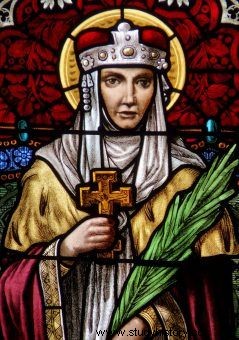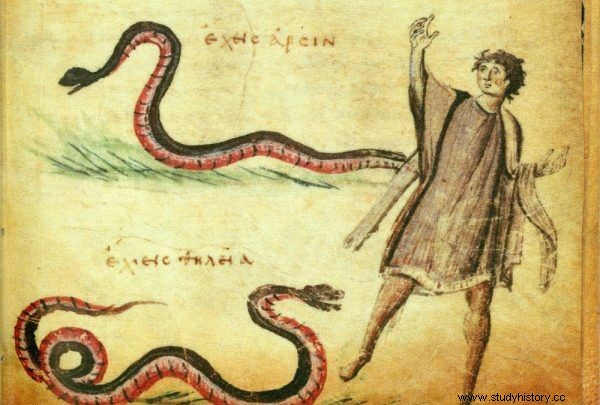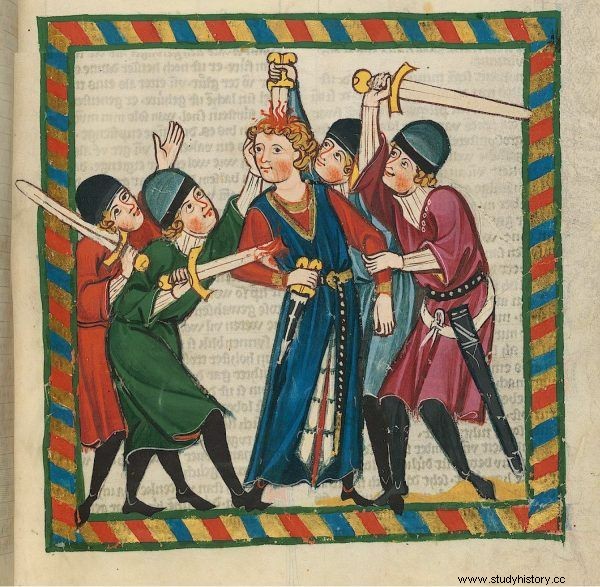Ruthless, suspicious, hateful. For Mieszko I's wife she was a model ruler. A grandmother from hell.
It was the year 921, probably autumn, when a detachment led by Tunna and Gommon invaded Tetín Castle, about thirty kilometers from Prague. Today Tetín is a sleepy village inhabited by just over eight hundred people. At the beginning of the 10th century, the number of its inhabitants was even more modest - but it was much more important, especially in the turbulent 921.
In mid-February, prince Vratislav of the Přemyslid dynasty perished while facing a plundering expedition by the Hungarian hordes. Nobody in the country was prepared for such a development. The ruler has just sat on the throne, replacing his prematurely deceased brother Spitygniew.
When he died, he was not even thirty-three years old. The country was on the brink of civil war. The mighty gathered at a rally in the capital city of the city chose the prince's firstborn son, Wenceslas, as their new ruler. He was elevated to the throne, but it did not solve the political crisis in any way.
Power instead of sons
The boy was only twelve or thirteen. Maybe in the light of the Slavic tradition he was almost of age, but it did not matter to the warriors from the princely team. They would never agree for a similar youngster to seize true power. A child with milk under his breath, sending husbands into battle and dealing with their lives? Never wait. Finally, after undoubtedly long and tiring deliberations, the decision was made to hand over the reins of government to women.

Saint Ludmila. Stained glass performances
Lyudmila, the mother of the late Vratislav, about sixty years old, was to take care of the education of the dynasty's descendants. Wacław and his younger brother Bolesław were placed in her care, with a clear order that she should prepare them for politics and warfare as soon as possible. The boys' mother, Drahomira, had lost her sons, but was by no means left empty-handed. It was she who was to exercise regency on behalf of Wacław until he was deemed ready to take the place entrusted to him.
We can guess that behind the two women there were competing parties of the mighty and warriors, and the division of responsibilities was determined in such a way that these forces would check each other, ensuring peace until the end of the regency. The plan seemed reasonable, but it was doomed to failure from the very first moment. He did not take into account how much distrust and even hatred existed between the young widowed duchess and her mother-in-law.
Only solution
It is difficult to reconstruct the exact course of events after a thousand years. One of the Czech historians researching the topic suggested that the dispute started earlier, during Vratislav's lifetime. The prince was to personally decide that Drahomira, as a poorly educated princess Stodoran brought up on the pagan Polabia, was not fit to be a guardian of her own children. And it was he who, against the protests of his wife, sent his sons to his mother's court, while the powerful at a rally in Prague only upheld this decision.
Such an interpretation of the sources would perfectly explain Drahomira's emotional reaction in 921. Although it took almost full power in the state, there was still little of it. She needed to prove that despite her culture and origin - or maybe thanks to them? - he has a much better predisposition than his old mother-in-law. And it's a predisposition to do just about anything.
It has also been suggested that the dispute was deeply political and even international. The oldest preserved records, however, indicate very down-to-earth motivations. Drahomira, "overwhelmed by evil suspicions, believed that because of the people entrusting the upbringing of the boys to her mother-in-law, she would seize all power for herself, and she herself would be deprived of power and property" - commented the well-known monk Krystian, who worked at the end of the 10th century. 
The way out of the situation, according to Drahomira, was only one:"She made the intention to kill [Ludmila] at all costs." That is why, in the same year, a branch of Tunny and Gommon was built near Tetín - a castle that was chosen for her seat by the grandmother of the family.
Specialists in the wet job
It is no coincidence that the names of the two commanders sound strange. They were probably Vikings in the service of the Czech princess. According to some, they came to Prague from the country of Stodoran, together with Drahomira. In the opinion of others - they came from Ruthenia, where they broke away from one of the teams of Wareska warriors. Whatever the case, these were exactly the people Drahomira needed:killing specialists with no strong ties to local elites, without moral dilemmas and not asking unnecessary questions.
The fact that by all accounts Tunna and Gommon had previously served in some character of Ludmila and had been captured by her daughter-in-law only added flavor to the whole affair. After all, the old duchess was to be killed by her own people, who opted for a more cunning, ruthless and - at least in their own opinion - rightful ruler.
Tunna and Gommon attacked the castle, broke into Ludmila's court and headed straight to the bedroom where she was hiding. "Did I not nourish you as sons?" I gave you gold, silver, precious garments, and if I have committed you in something, tell me this… ”- the terrified mother of the deceased prince tried to negotiate. There was no answer. The men, ignoring the cries and pleas, brutally threw the woman out of bed.

The Prague manor house was a real nest of vipers. One careless step meant certain death. Pictured in the image of poisonous snakes from the 10th century Byzantine codex.
Scrolling on the ground, Lyudmila was also to ask if they killed her in a dignified way, with a sword. At this appeal, the torturers also remained deaf. They grabbed the rope, wrapped it around the Duchess's neck and tightened the noose. As soon as the life was gone from the body, they dragged the carcass into the yard and buried it, like the body of a criminal or a suicide. Away from the church, in the mud under the fortifications of the stronghold. Apparently, according to Drahomira, this was the only thing her mother-in-law deserved.
Bloody cleanup
The following months were marked by bloody fights and settlements. Sources report the expulsion of Bavarian priests, apparently belonging to Ludmila's supporters. The ruler was rather not so kind towards the natives. If she killed her husband's mother in cold blood, she probably did the same to any noble who refused to subordinate her.
In 922, her authority was so certain that it even managed to repel an armed expedition of the Bavarians. The duchess also gained a new material foundation for her rule. She seized all the property formerly belonging to the wealthy, well-earned by her husband Ludmila. And of course, she wasn't even thinking about giving up power to her son.

Daylight murders and assassinations under cover of night. Drahomira made sure that practicing politics in the Czech Republic was never safe. The illustration shows a scene from the German "Manesse Code"
When she felt completely confident, she took care of covering up the traces of the crime. Tunna and Gommon would be the victims of her schemes. The former, having been warned in advance, managed to flee the country with his family. The other was not so lucky. The duchess' men captured him, while she, without hesitation, sentenced the man to death, washing her hands of any complicity in the murder of her mother-in-law. The state propaganda took care of the rest.
The earliest Czech works from the 10th century portray Drahomira as an exemplary wife, a loving mother and a wise regent , at best, a little too whispered by bad advisers.
The truth was to come to light only decades later, from the pen of a certain Krystian. Contrary to appearances, it was not a random figure, not a rank-and-file monk from one of the dozens of European monasteries. Under the monastic name of Krystian hid none other than ... the brother of the Polish ruler Dobrawa, the Czech prince Strachkwas. And also a grandson of the ruthless Drahomira.
